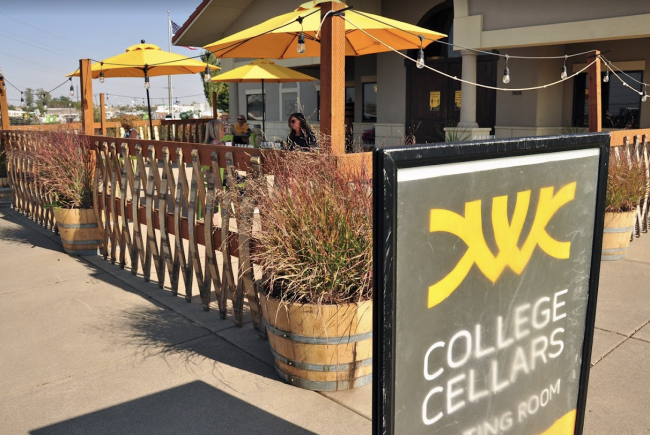You have /5 articles left.
Sign up for a free account or log in.

College Cellars of Walla Walla at Walla Walla Community College’s Center for Enology and Viticulture is one of the first two-year teaching commercial wineries in the U.S. The college’s efforts to promote local wine tourism is featured in a new Aspen Institute report on how small, rural colleges can turn challenges into assets.
College Cellars of Walla Walla
Relative to their more urban counterparts, rural community colleges have fewer prospective students and potential university partners. They often have fewer resources and a harder time recruiting and retaining employees. And they may face increased skepticism about higher education, especially if working-class jobs have historically dominated their local economies. That’s according to a new report from the Aspen Institute College Excellence Program.
But the report—based on interviews from rural college site visits and other research—is hardly gloom and doom. The main idea is that these colleges also have particular strengths that can be used to support student success.
Report co-author Ben Barrett, senior program manager at the Aspen Institute, says he’s struck by how small, rural colleges “not only overcome the limitations of their college’s and their community’s size but leverage it as an advantage.”
Limitations Become Opportunities
The report identifies four broad approaches used by strong rural community colleges to support student success within their contexts:
1. Create pathways to economic mobility: Excellent rural colleges work to understand their labor markets and ensure that programs of study align with “real opportunity,” Barrett and his co-authors write. These colleges also clearly communicate the value of strong programs to prospective students and local community members, as well as to enrolled students by incorporating hands-on learning.
Other strategies for creating pathways to economic mobility include:
- envisioning a larger service area to expand opportunity.
- combining workforce and transfer pathways to meet regional needs.
- creating new industries and employment opportunities for students.
Examples: Lake Area Technical College in South Dakota approves new programs if there is enough labor market demand for graduates to secure good jobs. In one case, this meant turning down livestock farmers’ requests that the college train large-animal veterinary technicians. In another case, this meant partnering with a health-care provider to build the Prairie Lakes Healthcare Center of Learning for nursing students. Programs are evaluated annually by student satisfaction, employer satisfaction, graduates’ wages and more. Walla Walla Community College in Washington helped develop the local area’s wine tourism industry, while Catawba Valley Community College in North Carolina set out to become a major auto mechanic hub for the southeastern U.S.
2. Convince students to enroll and stay in college: Whatever drives skepticism about college, Barrett and his co-authors find that strong rural colleges overcome it through thoughtful communications and outreach that meet students where they are. Such colleges also provide “strong, workforce-aligned educational programs that back their promises.”
Additional strategies for convincing students to stay in college are:
- adapting outreach as local demographics change
- investing in dual-enrollment programs
- providing resources to struggling high schools.
- advancing retention with equity in mind.
- removing the earn-or-learn dilemma for low-income students.
Examples: Zane State College in Ohio partners with regional employers in its Appalachian service area to create earn-and-learn opportunities in which students attend class two days a week. Then, for three days, they get on-the-job training related to their coursework. Patrick & Henry Community College in Virginia worked to meet the talent needs of new manufacturing employers in the area by persuading students that advanced manufacturing jobs are different from the unstable manufacturing jobs that had already left the community. It kicked outreach into high gear, inviting locals to campus to show off new facilities and explain opportunities, focusing on the advanced manufacturing program’s link to good jobs.
3. Build strategic partnerships to support student success: Rural community college leaders often foster relationships with local community members and businesses, but exceptional leaders “translate the rapport developed at business meetings, over coffee chats, and during regular run-ins at local events into sustained, mission-driven partnerships that provide high-quality opportunities for students, train workers for the regional economy, and deliver needed services for both,” the report says.
Other strategies for building partnerships to support student success:
- partnering with local employers and community organizations to generate mission-aligned resources.
- leveraging institutional consortia to enhance mission-aligned functions.
- partnering to expand bachelor’s attainment.
Examples: At Northwest Iowa Community College, President John Hartog turned casual conversations into a standing biweekly meeting of the “big five,” meaning county leadership, the city manager, the local K-12 superintendent and representatives from state legislators’ and congressional staffs. Their goal is to “take turns winning,” and they’ve worked together on capital improvement projects and complex challenges around housing shortages, clean water, fentanyl abuse and damage from windstorms. The college also partnered with a major tool manufacturer to reduce costs for automotive technology students. Instead of buying expensive tools at the start of the program, students can now use tools for a fee each term, with fees credited toward eventual purchase. Local companies also funded program instructor salaries for a time, until enrollment was up.
4. Make small size a strength: Rural colleges enroll an average of 2,500 students, fewer than a third of the national average, according to the report. Due to their small size, strong rural colleges often assign multiple roles to individual leaders. Barrett and his colleague say that “combining responsibilities—while at times burdensome—can increase coordination between different parts of the college and, in turn, strengthen the effectiveness of student success strategies.” Another strategy for making small size a strength is adopting relationship-driven advising.
Examples: Zane State College in Ohio combined information technology and institutional research into one department under a single executive director, “recognizing that IT systems hold much of the data that institutional researchers need to understand student needs and evaluate the effectiveness of student success strategies,” the report says. “In addition to saving money, this merger helped advance student success work by both enhancing the college’s data capacity and creating a structure to engage more leaders in student success data analysis.” Lake Area Technical College enrolls new students in a prescribed program of study with about 17 other peers who remain together throughout their program. Instead of professional advisers, faculty members in the program advise students in each cohort. New faculty advisers are mentored by veteran faculty advisers.
J. Gregory Hodges, president of Patrick & Henry Community College in a Virginia town of about 13,500 people, says that the “work of our institution is centered directly in our local business community.” The campus’s Manufacturing and Engineering Technology (MET) Complex, for example, which provides hundreds of credentials annually, was designed “specifically around the economic development work happening in our region.”
Is a community partnership helping students at your college or university succeed? Tell us about it.





